Complete Solutions to Exercise of chapter GASEOUS STATE of Class 11 book with complete answers and questions
| Class 11 | CHEMISTRY |
| Chapter | GASEOUS STATE |
| GRB PUBLICATION | Exercise |
| Number Of Questions | 100 |
| Academic Year | 2023-24 |
If pressure of a gas contained in a closed vessel is increased by `0.4%` when heated by `1^(@)C`, the initial temperature must be
View SolutionFor an ideal gas number of moles per litre in terms of its pressure `P` gas contant `R` and temperature `T` is .
View SolutionA thin balloon filled with air at `47^(@)C` has a volume of 3 litre. If on placing it in a cooled room its volume becomes 2.7 litre, the temperature of room is:
View SolutionIf a mixture of `3` mol of `H_(2)` and `1 "mole"` of `N_(2)` is completely converted into `NH_(3)`, what would be the ratio of the initial and final volume at same temperature and pressure?
View Solution`SO_(2)` at STP contained in a flask was replaced by `O_(2)` under identical conditions of pressure, temperature and volume. Then the weight of `O_(2)` will be.... Of `SO_(2)`
View SolutionAssuming that `O_(2)` molecule is spherical in shape with radiusw `2overset(@)A`, the percentage of the volume of `O_(2)` molecules to the total volume of gas at S.T.P. is :
View SolutionTwo flasks of equal volume connected by a narrow tube (of negligible volume) are at `27^(@)C` and contain 0.70 mole of `H_(2)` to 0.5atm One of the flask is then immersed into a bath kept at `127^(@)C` while the other remains at `27^(@)C` Calculate the final pressure and the number of mole of `H_(2)` in each flask .
View SolutionTwo flasks of equal volume connected by a narrow tube (of negligible volume) are at `27^(@)C` and contain 0.70 mole of `H_(2)` to 0.5atm One of the flask is then immersed into a bath kept at `127^(@)C` while the other remains at `27^(@)C` Calculate the final pressure and the number of mole of `H_(2)` in each flask .
View SolutionA gas is heated from `0^(@)C` to `100^(@)C` at 1.0 atm pressure. If the initial volume of the gas is 10.0L, its final volume would be:
View SolutionUnder what conditions will a pure sample of an ideal gas not only exhibit a pressure of `1 atm` but also a concentration of `1 mol litre^(-1)`
`[R= 0.082` iltre atm `mol^(-1)K^(-1)]`
View SolutionA and `B` are two idential vessels. `A` contains `15 g` ethane at `1 atm` and `298 K`. The vessel `B` contains `75 g` of a gas `X_(2)` at same temperature and pressure. The vapour density of `X_(2)` is :
View SolutionThe density of neon will be highest at
View SolutionA `0.5 dm^(3)` flask contains gas `A` and `1 dm^(3)` flask contains gas `B` at the same temperature. If density of `A= 3g//dm^(3)` and that of `B= 1.5g //dm^(3)` and the molar mass of `A= 1//2` of `B`, the ratio of pressure excerted by gases is:
View SolutionIf molecular mass of `O_(2)` and `SO_(2)` are 32 and 64 respectively. If one litre of `O_(2)` at `15^(@)C` and 759mm pressure contains N molecules, the number of molecuels in two litre of `SO_(2)` under the same conditions of temperature and pressure will be:
View SolutionLithium reacts with water to produce hydrogen gas and lithium hydroxide. What volume of hydrogen collected over water at `22^(@)C` and 750mm Hg pressure is produced by the reaction of 0.208g of Li?
`[VP_(H_(2)O)=19.8mm Hg][Li=7]`
View SolutionTwo flasks of equal volume is connected by a narrow tube (of negligible volume) contains a certain amount of `N_(2)` gas at 2 atm and `27^(@)C`. The 1st flasks is then immersed into a bath kept at `47^(@)C` while the 2nd flask is immeresed into a bath kept at `127^(@)C`. the ratio of the number of moles of `N_(2)` in 1st flask to the 2nd falsk after sometime will be?
View SolutionA gas of volume 100cc is kept in a vessel at pressure `10^(4)` Pa maintained at temperature `24^(@)C`. If now the pressure is increased to `10^(5)` Pa, keeping the temperature constant, then the volume of the becomes:
View SolutionThe volume of helium is `44.8 L` at
View Solution2.5L of a sample of a gas at `27^(@)`C and 1 bar pressure is compressed to a volume of 500mL keeping the temperature constnat, the percentage increase in pressure is:
View SolutionA bottle is heated with mouth open to have a final temperature as five times its original value at `25^(@)C`. The fraction of air originally present in the bottle that is expelled, is:
View SolutionThe density of a gas `A` is twice that of a gas `B` at the same temperature. The molecular mass of gas `B` is thrice that of `A`. The ratio of the pressure acting on `A` and `B` will be
View SolutionThe air contains 78% and 22% `O_(2)` by volume. The volume occupied by 40g air at `20^(@)C` and 745 mm Hg pressure approximately:
View SolutionA cylinder containing cooking gas can withstand a pressure of `15 atm`. The pressure gauge of the cylinder indicates `12 atm` at `27^(@)C`. Due to a sudden fire in the building, the temperature starts rising. At what temperature will the cylinder explode?
View SolutionAt `100^(@)C` and 1 atm, if the density of the liquid water is `1.0 g cm^(-3)` and that of water vapour is `0.0006 g cm^(-3)` , then the volume occupied by water molecules in `1 L` steam at this temperature is
View SolutionA 2.00 litre evacuated container has a mass of 1050.0g. When the container is filled with an unknown gas at 800mm Hg pressure and `25.0^(@)C` the mass is 1052.4g. What is the molar mass of the gas (in `g"mol"^(-1)`)?
View SolutionA sample of oxygen gas and a sample of an unknown gas are weighed separately in the same evacuated flask. Use thedata given below to find the molar mass of the unknown gas (assume experiments are carried out at the same pressure and temperature).
`|:(" Mass of evacuted flask",,124.46 g),(" Mass of flask+oxygen",,125.10g),("Mass of flask+unknown gas",,125.34 g):|`
View SolutionValue of gas constant `R` is .
View SolutionWhich of the following parameteres would be expected to have the same values for `C_(2)H_(5)OH` and `CH_(3)OCH_(3)`?
View SolutionWhich of the following is not the correct set of pressure and volume at constant temperature and constant moles of gas?
View SolutionJust below this temperature gaases would theroretically have a negative volume (which is however not possible):
View SolutionThe volume of a gas increases by a factor of 2 while the pressure decrease by a factor of 3 Given that the number of moles is unaffected, the factor by which the temperature changes is `:`
View SolutionIf `V_(0)` is the volume of a given mass of gas at 273K at constant pressure, then accoding to Charle's law, the volume at `10^(@)C` will be:
View SolutionOn a ship sailing in pacific ocean, where temperature is `22^(@)C`, a balloon is filled with 2L air. What will be the voume of balloon when the ship reaches Indian ocean, where temperature is `27^(@)C`? The atmospheric pressure is same over pacific ocean and Indian ocean.
View SolutionAt constant volume, the temperature (in `.^(@)C`) of certain mass of a gas is increased by `20%`. The pressure of gas:
View Solution0.1 mole of argon has pressure P and temperature 7K in the vessel. On keeping the vessel at `50^(@)C` higher temperature, 0.8g of argon was given out to maintain same pressure. The original temperature was: [Ar=40]
View SolutionA weather balloon filled with hydrogen at `1` atm and `300` K has volume equal to `12000` liters. On ascending it reaches a place where temperature is `250` K and pressure is `0.5` atm. The volume of the balloon is :
View SolutionFour one litre flasks are separately filled with the gases, `O_(2),F_(2),CH_(4)` and `CO_(2)` under the same conditions. The ratio of number of molecules its these gases:
View SolutionAt 0.821 atm and at `177^(@)C`, gas `SO_(3)` occupies 45L Moles of neutrons present in `SO_(3)` are: (Take `N_(A)=6xx10^(23)`)
View SolutionA gas sample in a flexible container is maintained at constant pressure while its temperature is increased from `25^(@)C` to `75^(@)C`. If the initial volume of the gas is 4.2L, what is the change in volume due to the temperature increase?
View SolutionA sample of an ideal gas has volume of 0.500L at `25^(@)C` and 1.20 atm pressure. What is its volume at `75^(@)C` and 3.60 atm?
View SolutionA sample of gas occupies a volume of 9.23L at 345K and 1.40atm. What is its volume at 525K and 3.20 atm?
View SolutionWhen 0.25L of liquid nitrogen (d=0.807g/mL) is vaporized, what volume does the resulting gas occupy at `25^(@)C` and 5.00 atm?
View SolutionA sample of He gas in a flexible container at room temperature exhibits a certain pressure. What will be the new pressure when the absolute temperature and volume of the container are both halve? The pressure of the He will be:
View SolutionA 3.0L sample of helium gas is stored in a rigid, sealed container at `25^(@)C` and 1.0 atm pressure. The temperature is increased to `125%(@)C`. What is the new pressure of the gas?
View Solution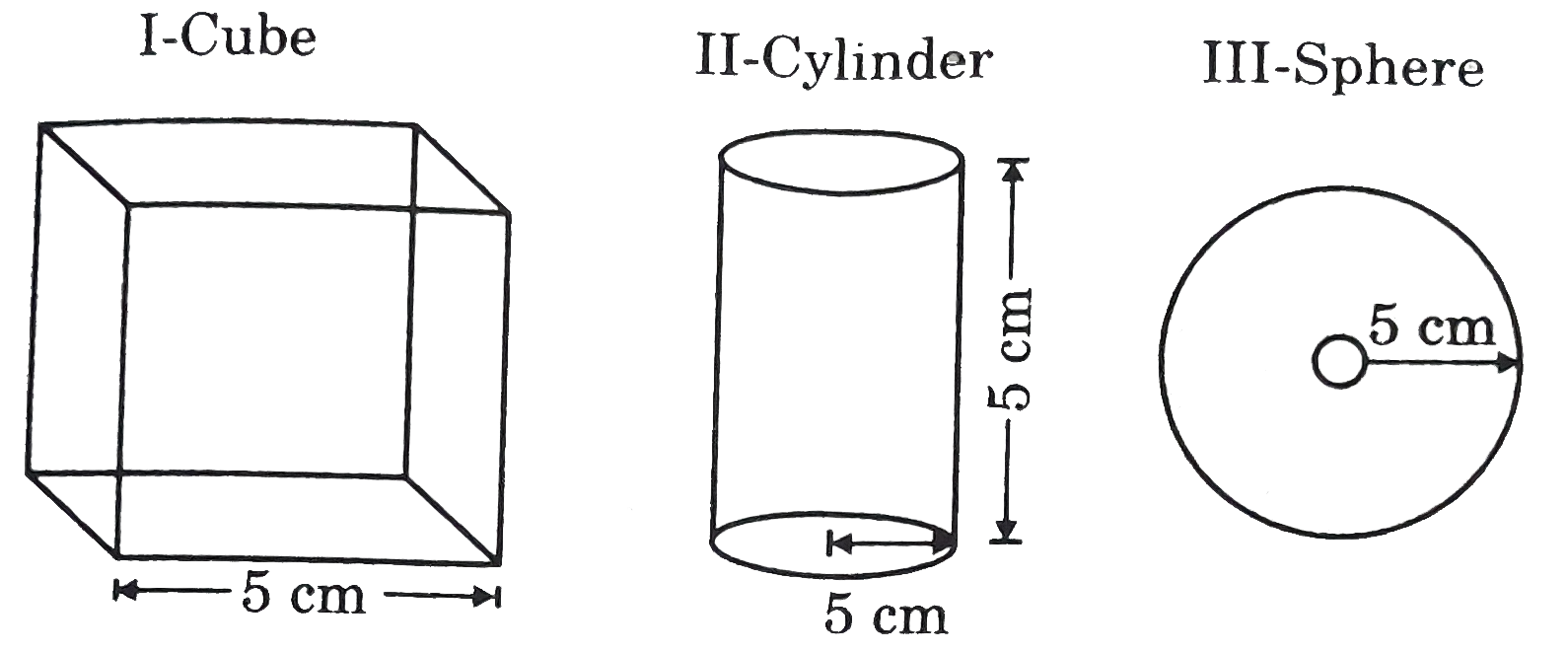
There are three closed containers in which equal moles of gas is filled if the containers are placed at the same temperature, then which of the following is correct?
View SolutionValue of absolute zero of temperature in degree Celsius `(.^(@)C)` can be determined by given data. The density of an ideal gas at `25^(@)C` and `100^(@)C` are 1.5 and 1.2g/L, respectively, both at the same pressure. The value of absolute zero of temperature in degree Celsius `(.^(@)C)`:
View SolutionWhich gas has a density of 0.71 `gL^(-1)` at `0^(@)C` and 1 atm?
View SolutionA 2.00L balloon at `20.0^(@)C` and 7.45mm Hg floats an altitude where the temperature is `10.0^(@)C` and the air pressure is 700mm Hg. What is the new volume of the balloon?
View SolutionA sample of gas at 273K has a pressure of `P_(1)` and a volume of `V_(1)`. When the pressure is changed to `P_(2)`, what is the volume `V_(2)`? (Assume the temperature remains constant)
View SolutionA gas in a closed, flexible container is slowly cooled from `50^(@)C` to `25^(@)C`. What is the ratio of the final volume of the gas to its initial volume? (Assume ideal behaviour).
View SolutionA sample of `C_(2)H_(6)` gas initially at `50^(@)C` and 720 mm Hg is heated to `100^(@)C` in a container of constant volume. What is the new pressure (in mmHg)?
View SolutionWhat is the molar mass of a gas if 10.0 grams of it occupy 4.48 litres at 273K and 101.3 kPa (1.00 atm)?
View SolutionWhich gas has the same density at `546^(@)C` and 1.50 atm as that of `O_(2)` gas at 1 atm and `0(@)C`?
View SolutionA gas has a volume of 6.0L at a pressure of 0.80 atm. What is the volume if the pressure is changed to 0.20atm at constant temperature?
View SolutionWhat pressure (in atm) will be exerted by a 1.00g sample of methane, `CH_(4)` in a 4.25L flask at `115^(@)C`?
View SolutionA sample of neon gas has a volume of 248 mL at `30^(@)C` and a certain pressure. What volume would it occupy if it were heated to `60^(@)C` at the same pressure?
View SolutionIn an experiment, it was found that for a gas at constnat temperature, PV=C. The value of C depends on:
View SolutionA quantity of hydrogen gas occupies a volume of 30.0mL at a certain temperature and pressure what volume would half this mass of hydrogen occupy at triple the above temperature if the pressure were one-ninth that of the original gas?
View SolutionA spherical air bubble is rising from the depth of a lake when pressure is P atm and temperature is T K. The percentage increase in its radius when it comes to the surface of lake will be: (Assume temperature and pressure at the surface to be respectively `2 TK` and `(P)/(4)`)
View SolutionFor one mole of ideal gas if `P=(P_(0))/(1+((V)/(V_(0))))` where `P_(0)` and `V_(0)` are constant, then temperature of gas when `V=V_(0)` is:
View SolutionA gas at a pressure of 5.0 atm is heated from `0^(@)C` to `546^(@)C` and simultaneously compressed to one-third of its original volume. Hence, final pressure is:
View SolutionA motorist inflates the tyres of her car to a pressure of 180 kPa on a day when the temperature is `-8^(@)C`. When she arrives at her destination, the tyres pressure increased to 245 kPa. What is the temperature of the tyres if we assume that the tyres expand by 7%?
View Solution`O_(2)` gas is placed in a 4 litre container containing 3 L of liquid water as shown and total pressure exerted by gases is 720mm Hg.
What will be the pressure of `O_(2)(g)` if given container is attached to a empty container of 3 litre at same temperature?
Given : [V.P. of `H_(2)O` at `27^(@)C=20mm` of Hg]
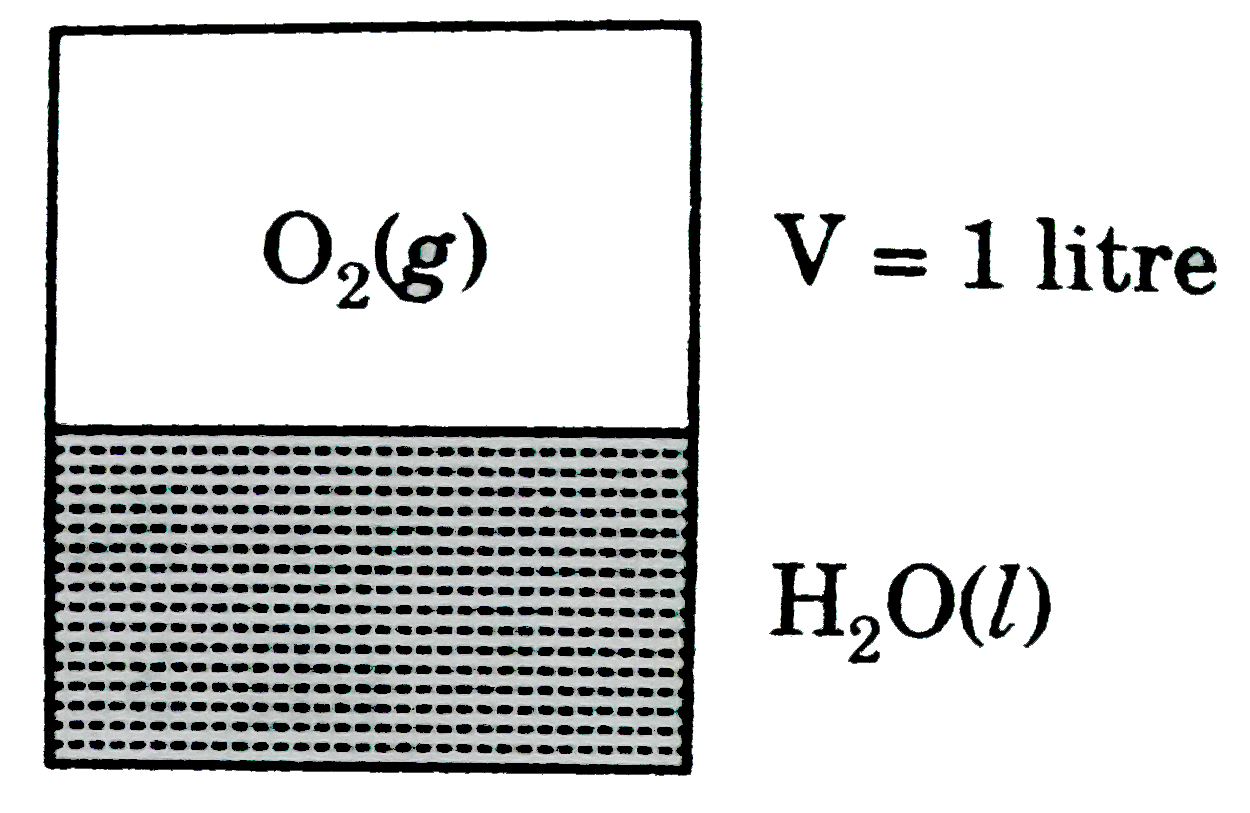
View SolutionFrom the following set-up, calculate moles of the gas present in the container of volume 24.63 litre at 600K if the level of mercury in the open tube of the manometer is 36cm higher.
[Given: Atmospheric pressure=78cm of mercury]
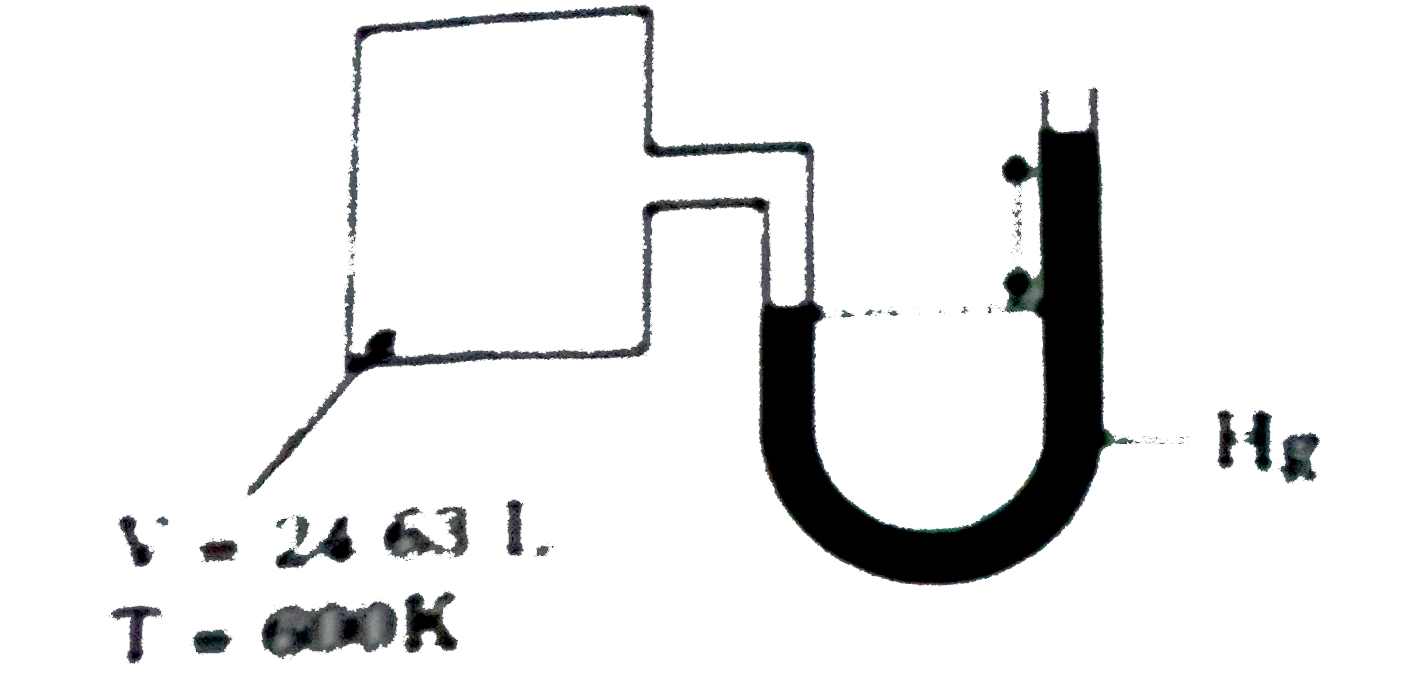
View SolutionIf air is assumed to be at temperature 290K with molar mass 29 gm/mol and g=`10m//s^(2)` then change in pressure at height 8.314km and ground level as a fraction of pressure at ground level is given by:
View SolutionOn the surface of the earth at 1 atm pressure, a balloon filled with `H_(2)` gas occupies 500mL. This volume is `(5)/(6)` of its maximum capacity. The balloon is left in air. It starts rising. The height above which the balloon will burst if temperature of the atmospere remains constant and the pressure decreases 1 mm for every 100cm rise of height is:
View SolutionA quantity of gas is collected in a graduated tube over the mercury. The volume of gas at `18^(@)C` is 50 mL and the level of mercuty in the tube is 100mm above the outside mercuty level. The barometer reads 750 torr. Hence, volume of gas 1 atm and `0^(@)C` is approximately:
View SolutionA gas `A_(x)` having mass of 100g is confined in a container of volume 16L maintained at 300K and a manometer is attached as shown, value of x is: (R=0.08 atm-L/mole-K)
(Atomic mass of A=24)

View SolutionIn a glass tube columns of water and mercury appear as shown.
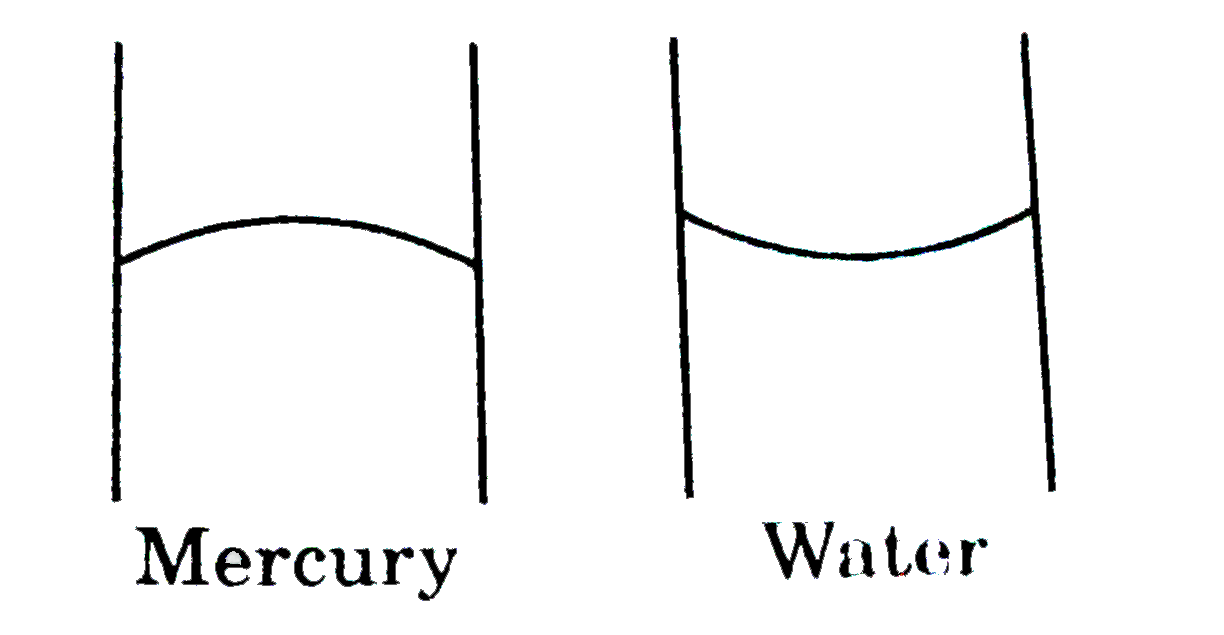
This is best attributed to the differences in their:
View SolutionMoist air is less dense than dry air at the same temperature and barometric pressure. Which is the best explanation for this observation?
View SolutionWhat is the major reason for using mercury (rather than water) in barometers?
View SolutionA gas is collected in the flask shown here. What is the pressure exerted by the gas is the atmospheric pressure is 735 mmHg?
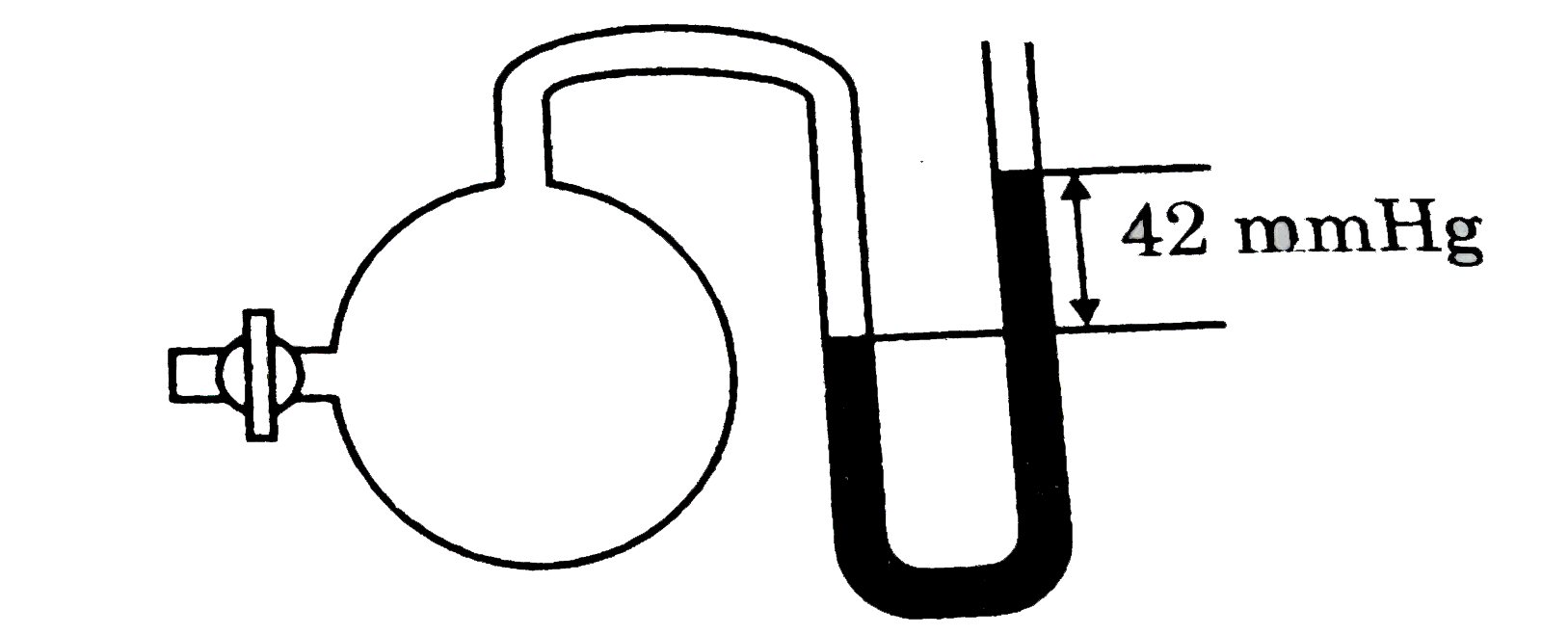
View SolutionThe vapour pressure of water at `20^(@)C` is `17.54 mmHg`. What will be the vapour pressure of the water in the apparatus shown after the piston is lowered, decreasing the volume of the gas above the liquid to one half of its initial volume (assume temperature is constant).
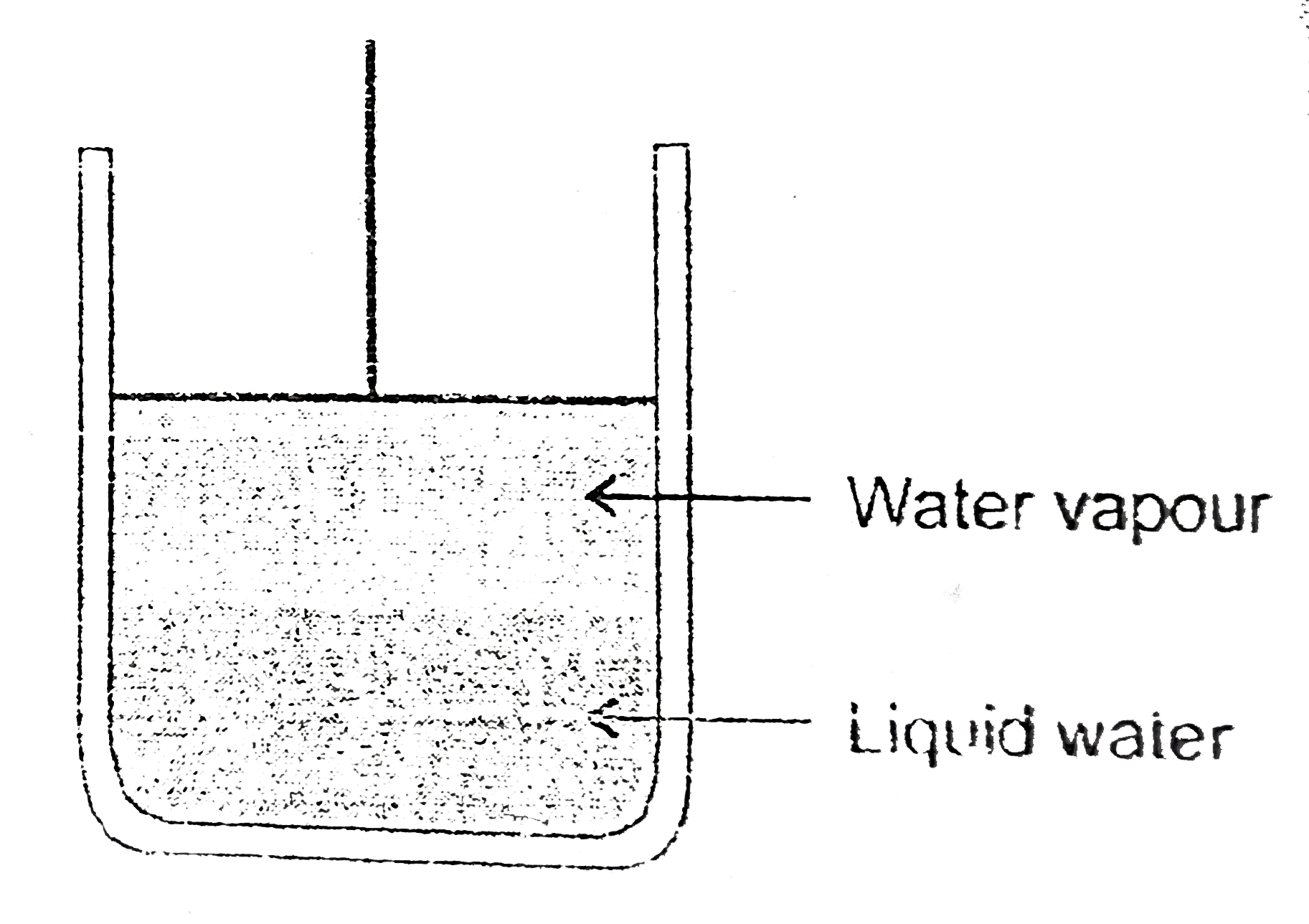
View SolutionAt `20^(@)C` vapour pressure of `H_(2)O(l)` is recorded as 28.57m bar. The initial and final vapour pressure of `H_(2)O(l)`, if volume of container containing `(H_(2)O(l)` is increased from 5 litre to 10litre, are:

View SolutionA closed end manometer is filled with Hg as shown in the following diagram at `27^(@)C` and volume of the bulb is 150mL At this temperature, the vapour pressure of water is 28mm of Hg. If the bulb contains 0.001 mol of `O_(2)(g)` then find the volume of liquid water. (Given that R=0.082 L atm `"mol"^(-1)K^(-1)`)
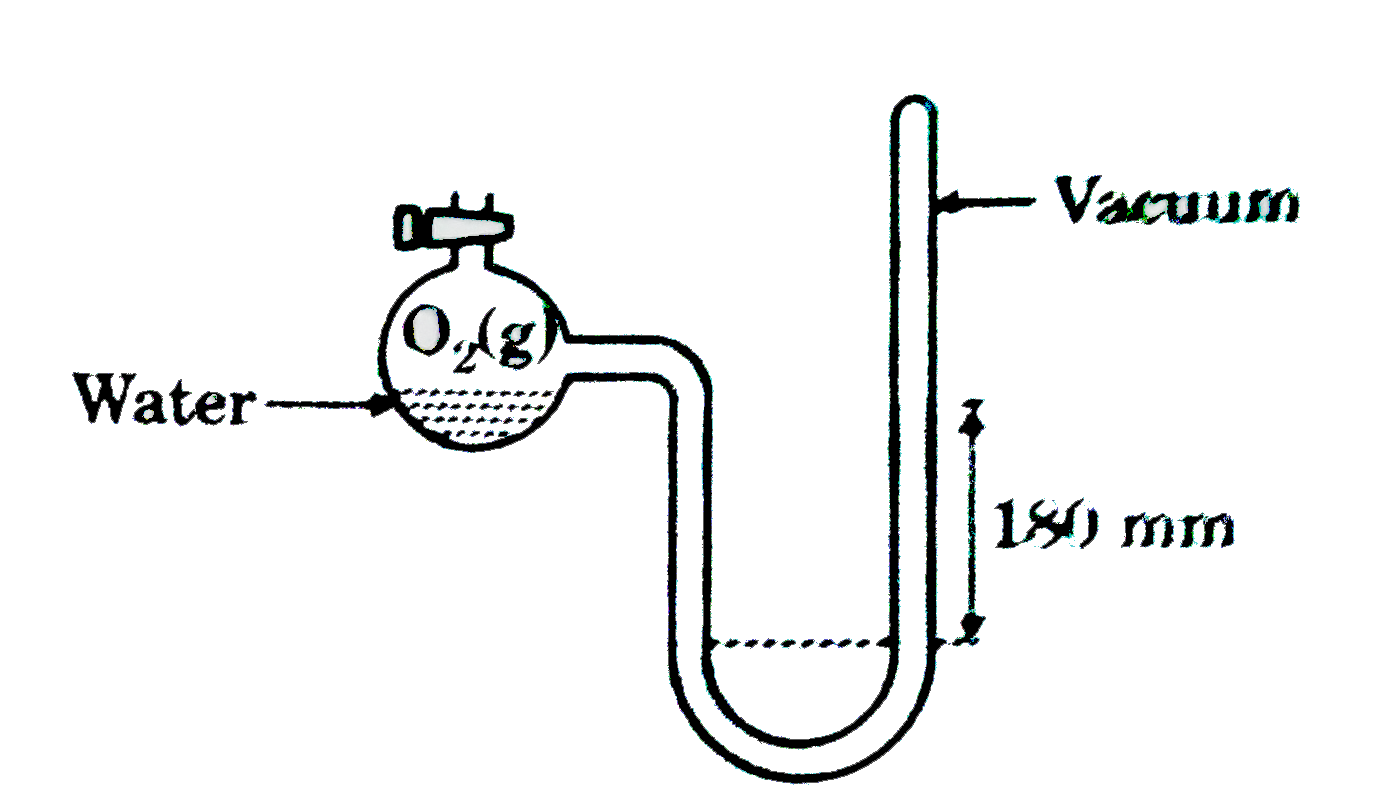
View SolutionAt any top of the mountain the thermoneterreads `0^(@)C` and the harometer reads 710 mm Hg. At the bottom of the mountain the temperature is `40^(@)C` and pressure is 760mm Hg. Ratio of density of air at the top with that at the bottom is:
View SolutionA certain mountain is 14.100 feet above sea-level. The pressure a the top is 17.7 inches of Hg. If you blew up a balloon at sea level, where the pressure measured to be 29.7 inches and carried it to the top of the mountain, by what, factor would its volume change w.r.t. final volume?
View SolutionFind pressure (in atm) at point A, 10 cm above the bottom of container:

View SolutionA contaienr of volume 2 litre contains `H_(2)` gas at 300 K as shown `(P_("atm")=76cm "of" Hg)`
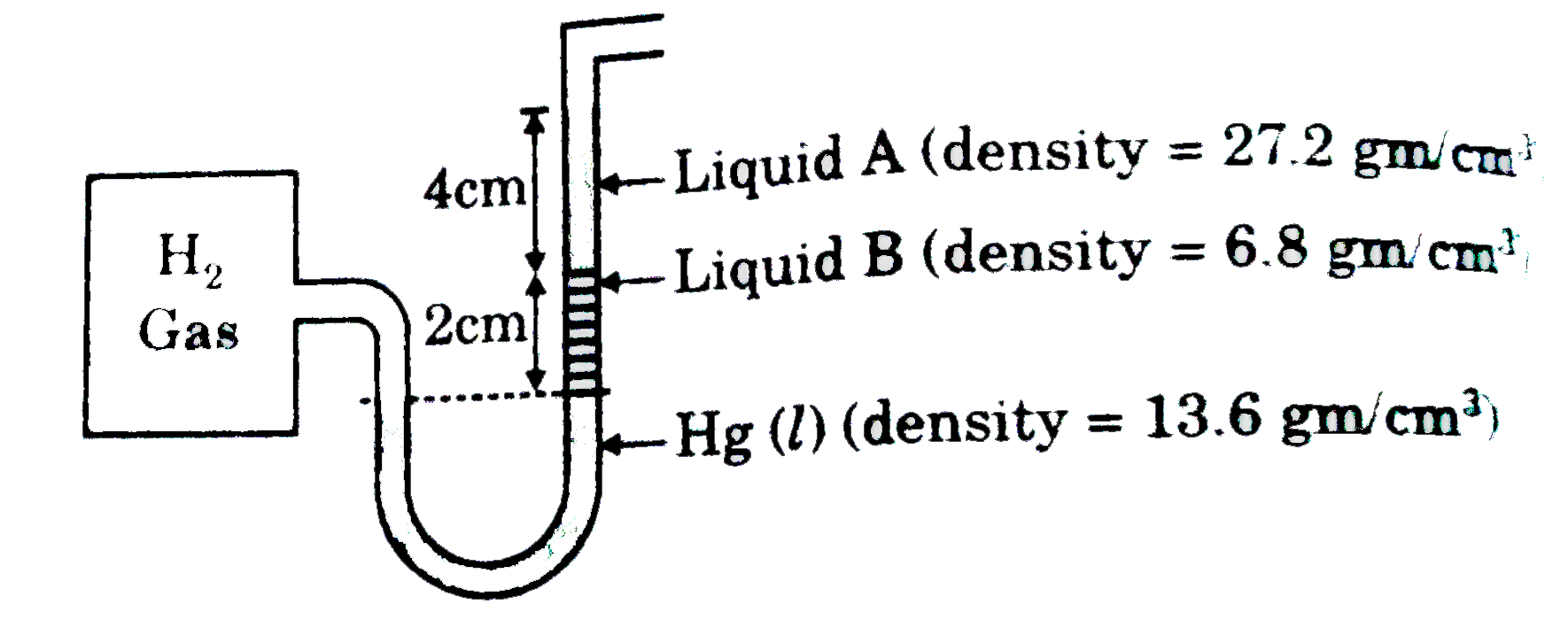
The pressure (in cm Hg) of `H_(2)` in the contaienr is
View SolutionIn the figure shown the pressure of the confined gas will be:
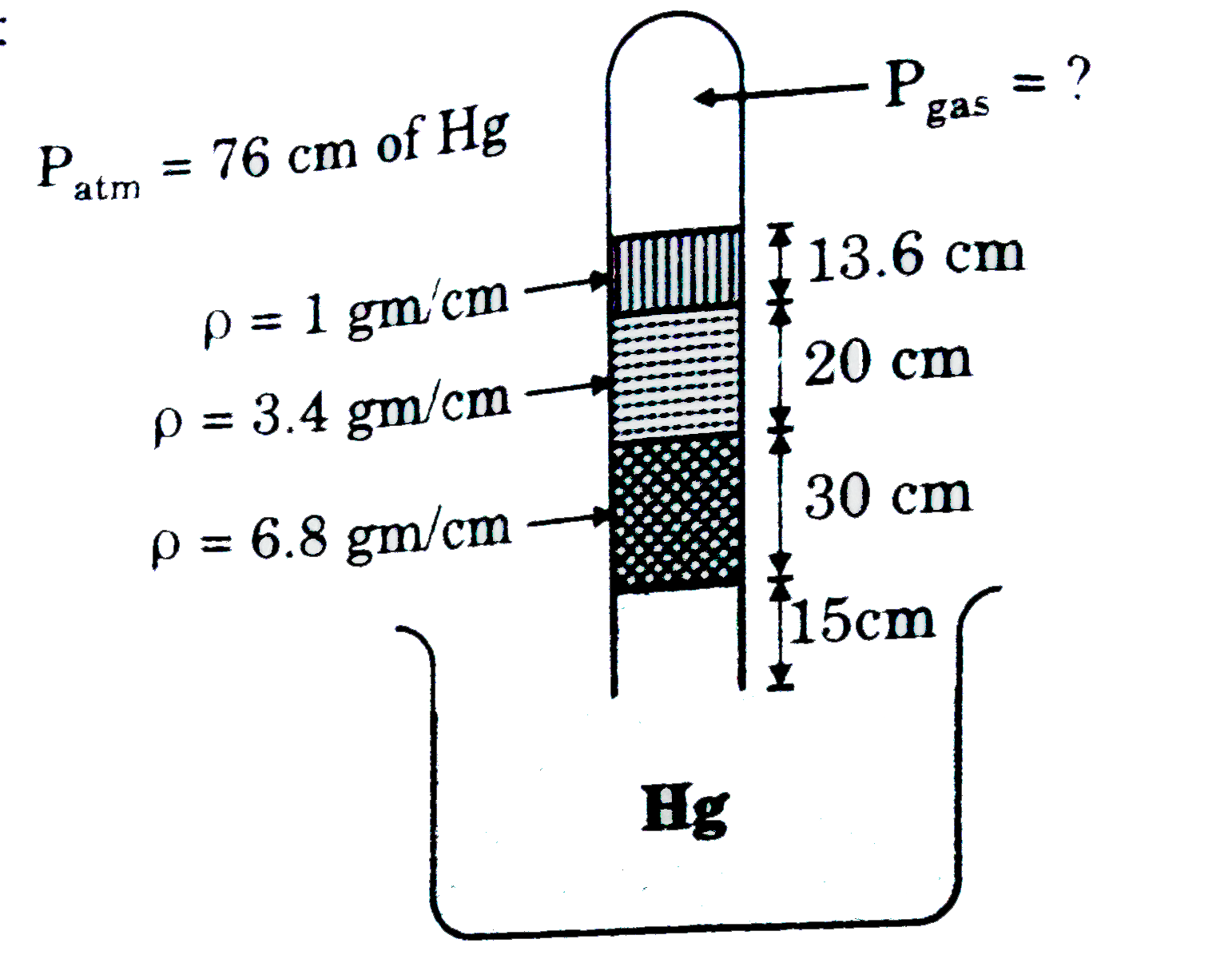
View Solution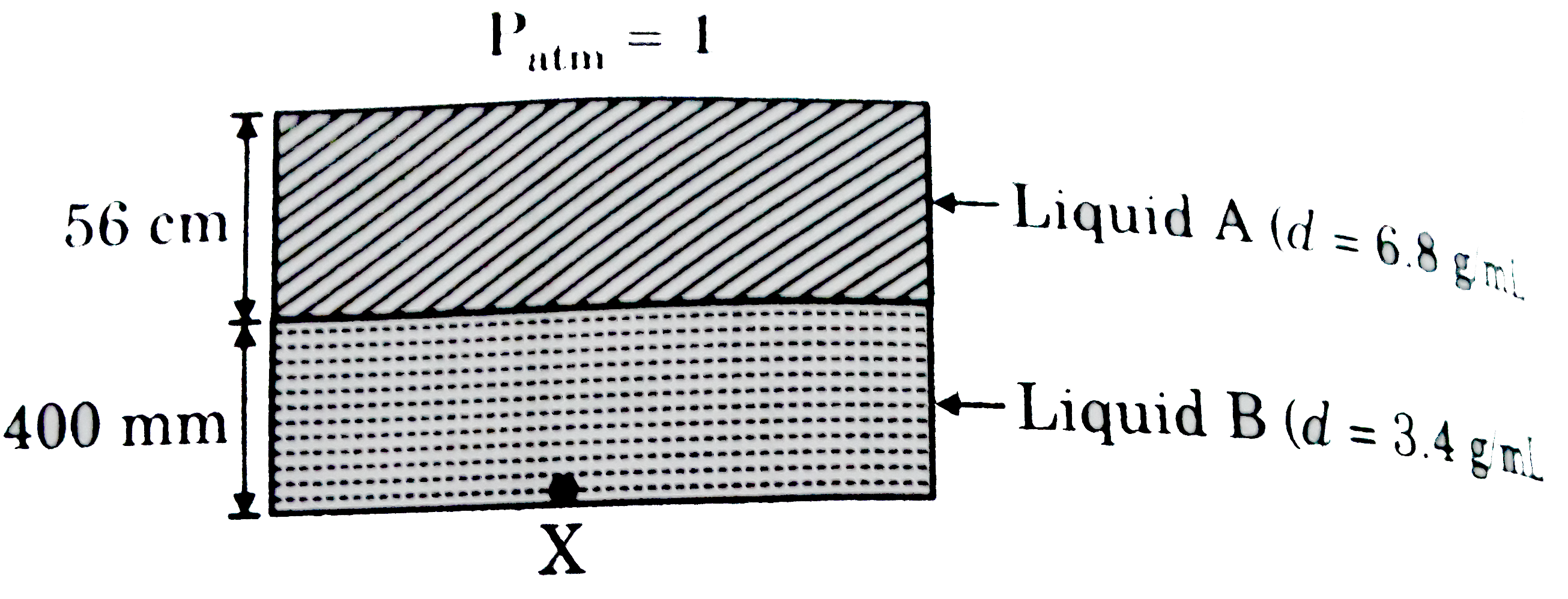
Total pressure at point (X) is:
View SolutionEqual weights of ethane and hydrogen are mixed in an empty container at `25^(@)C`. The fraction of the total pressure exerted by hydrogen is
View SolutionA mixture of hydrogen and oxygen at one bar pressure contains 20% by weight of hydrogen partial pressure of hydrogen will be:
View SolutionA compound exists in the gaseous phase both as monomer `(A)` and dimer `(A_(2))` The mol wt of `A` is 48 In an experiment `96g` of compound was confined in a container of volume `33.6` litre and heated to `273^(@)C` Calulate the pressure developed if the compound exists as dimer to the extent of `50%` by weight under same these conditions .
View SolutionA mixture contains `N_(2)O_(4)` and `NO_(2)` in the ratio 2:1 by volume. The vapour density of the mixture is:
View SolutionTwo glass bulbs A (of 100 mL capacity), and B (of 150mL capacity) containing same gas are connected by a small tube of negligible volume. At particular temperature the pressure to A was found to be 20 times more than that in bulb B. the stopcock is opened without changing the temperature. the pressure in A will:
View SolutionFor 10 minutes each, at `0^(@)C`, from two identical holes nitrogen and an unknown gas are leaked into a common vessel of 4 litre capacity. The resulting pressure is 2.8 atm and the mixture contains 0.4 mole of nitrogen. What is the molar mass of unknown gas ? (Take `R = 0.821 "L-atm mol"^(-1)K^(-1)`]
View SolutionOxygen and cyclopropane at partial pressures orf 570 torr and 170 torr respectively are mixed in a gas cylinder. What is the ratio of the number of moles of cyclopropane to the number of moles of oxygen?
View SolutionA vessel of volume 5 litre contains 1.4 g of nitrogen at a temperature 1800K. The pressure of the gas is 30% of its molecules are dissociated into atoms at this temperature is:
View SolutionEqual masses of methane and oxygen are mixed in an empty container at `25^(@)C`. The fraction of the total pressure exerted by oxygen is:
View Solution`N_(2)+3H_(2)rarr2NH_(3)`. 1 mol `N_(2)` and 4 mol `H_(2)` are taken in 15L flask at `27^(@)C` After cmomplete conversion of `N_(2)` into `NH_(3),5L` of `H_(2)O` is added pressure set up in the flask is:
View SolutionA sample of impure air contains 80% `N_(2)`. 10% 5% `CO_(2)` and 5% Ar by volume. The average molecular weight of the sample is : [Ar=40]
View SolutionThe density of a gas `A` is twice that of a gas `B` at the same temperature. The molecular mass of gas `B` is thrice that of `A`. The ratio of the pressure acting on `A` and `B` will be
View SolutionA container consists of 1 mole of liquid water and 1 mole of `N_(2)(g)`, at a temperature of 300K. If aqueous tension of water at 300K is 38mm of Hg and the contaienr is fitted with a piston operating at 0.1321 atm then calculate volume occupied by `N_(2)` gas:
(R=0.0821atm L/molk)
View SolutionThe vapour density of a aseous mixture of non-reactive gases 'A' and 'B' is 40. if the molar mass of gas 'A' is 20 g/mol and the mixture contains the gases in 2:3 volume ratio, then the molar mass of gas 'B' is
View SolutionThe partial pressure of hydrogen in a flask containing two grams of hydrogen and 32 g of sulphur dioxide is:
View SolutionEqual volume of two gases which do not react together are enclosed in separate vessels. Their pressures are 10mm and 400mm respectively. If the two vessels are joined together, then what will be the pressure of the resulting mixture (temperature remaining constant)?
View SolutionWhat is the total pressure exerted by the mixture of `7.0g ` of `N_(2),2g` of hydrogen and `8.0g` of sulphur dioxide gases in a vessel of `6L` capacity that has been kept at `27^(@)C`.
View SolutionA 40 mL of a mixture of `H_(2)` and `O_(2)` at `18^(@)C` and 1 atm pressure was sparked so that the formation of water was complete. The remaining pure gas had a volume of 10mL at `18^(@)C` and 1 atm pressure. If the remaining gas was `H_(2)`. The mole fraction of `H_(2)` in the 40mL mixture is:
View SolutionA gaseous mixture contains three gaseous `A,B` and `C` with a total number of moles of 10 and total pressure of `10 atm`. The partial pressure of `A` and `B` are `3 atm` and `1` atm respectively and if `C` has molecular weight of `2 g //mol`. Then, the weight of `C` present in the mixture will be `:`
View Solution
Exercise questions and complete solutions for chapter GASEOUS STATE of GRB CHEMISTRY (HINGLISH) of Class 11